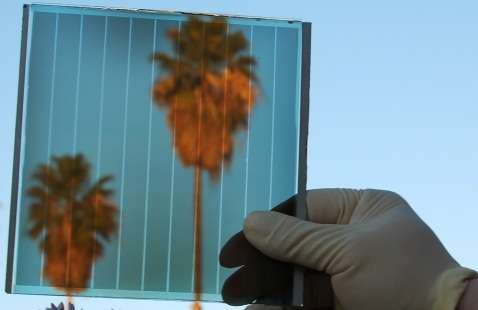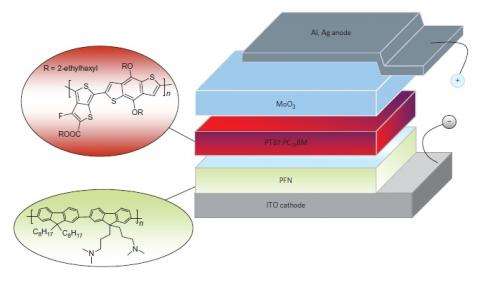August 31, 2012 feature
Inverted polymer solar cell efficiency sets world record

(Phys.org)—For many years, researchers have strived to reach the goal of 10% efficiency for polymer-based organic photovoltaic (OPV) solar cells, a target widely considered to be the threshold for commercial applications. Now in a new study, researchers at the South China University of Technology in Guangzhou have constructed an inverted OPV that has set a new record with a certified efficiency of 9.2%, a significant improvement over the previous record-high efficiency of 8.37%. Expecting the new design to catalyze developments to the 10% target in the near future, the research team is partnering with Houston-based Phillips 66 and Solarmer, a photovoltaic company in El Monte, California, to prepare for commercialization.
"In my opinion, the 10% target is not necessary for mass production; 5-8% is good enough for this emerging photovoltaic technology," Hongbin Wu, a professor at South China University of Technology, told Phys.org. "The 10% is a well-accepted figure by the organic electronic community. However, since OPVs can be produced via a very cost-effective way, lower power conversion efficiency is fine."
Although silicon solar cells have efficiencies climbing above 20%, the researchers emphasize that OPV's low-cost production will make them competitive with the more expensive silicon cells. However, the plastic-based OPVs have had to overcome another problem in order to attract commercial interest: low stability that leads to short lifetimes. This problem stems in part from the cathode, which is often made of a reactive metal that easily oxidizes in air. Although encapsulating the cathode can minimize degradation, researchers have discovered that they can completely eliminate the need for this reactive metal by inverting the device architecture.
In an inverted cell, the electric charges exit the device in the opposite direction as in a normal device. This happens because the positive and negative electrodes (which absorb the negative and positive charges, respectively) are reversed. Inverting the device architecture allows researchers to make the cathode out of a more suitable material; in this case, the researchers used indium tin oxide (ITO) modified with the polymer PFN.

While inverted OPVs enjoy longer lifetimes compared to regular OPVs, they typically don't reach efficiencies as high as regular OPVs. But the current study has overturned this stereotype that inverted OPVs have inferior performance, demonstrating that OPVs can exhibit both good stability and high efficiency.
To achieve this good performance, the researchers took advantage of a characteristic of inversion that is often overlooked: the ability to provide independent control of photon harvesting from the Sun's spectrum, which can lead to increased absorption of photons. The cell's photoactive layer, sandwiched between the two electrodes, absorbs incoming photons and photogenerates charge carriers. As a result of the new improvements, the photoactive layer can harvest more photons than a regular structure and therefore generate a higher electric current density of 17.2 mA/cm2, compared with 15.4 mA/cm2 for the regular device.
"The key point lies in the device structure itself," Wu said. "When the conjugated polymer PFN is used as the interlayer between the ITO substrate and photoactive layer, it can both provide ohmic contact for electron extraction and optimize photon harvest."
The higher current enables the device to achieve its record efficiency, which was certified by the Newport Technology & Application Center's Photovoltaic Lab in Long Beach, Calif.
In terms of stability, tests showed that the inverted OPVs retained 95% of their initial efficiency after 62 days, whereas the regular devices lost half their initial efficiency after 10 days.
As a bonus, the researchers also demonstrated that the design works for making semi-transparent inverted PSCs, which might be used in windows, curtains, and invisible electronic circuits.
Further, the researchers have calculated that their new design could reach the 10% target by making some reasonable improvements. By collaborating with Phillips 66 and Solarmer, they hope to bring the first OPV products to the market some time next year.
"I am confident that, at the laboratory level, an efficiency of 10% can be reached very soon," Wu said. "We continue to try our best to optimize OPV efficiency in all aspects (from a variety of materials system, device structures). When the efficiency can meet the requirement for further applications, we will conduct more in-depth investigations on stability. Also, we are carrying out research on low-cost manufacturing via ink-jet printing, roll-to-roll printing, etc."
More information: Zhicai He, et al. "Enhanced power-conversion efficiency in polymer solar cells using an inverted device structure." Nature Photonics. DOI: 10.1038/NPHOTON.2012.190
Press release: Phillips 66, South China University of Technology, and Solarmer Energy Set a World Record in Solar Power Conversion Efficiency
http://www.phillips66.com/EN/newsroom/news_releases/2012NewsReleases/Pages/08-21-2012.aspx
Journal information: Nature Photonics
Copyright 2012 Phys.org
All rights reserved. This material may not be published, broadcast, rewritten or redistributed in whole or part without the express written permission of PhysOrg.com.


















